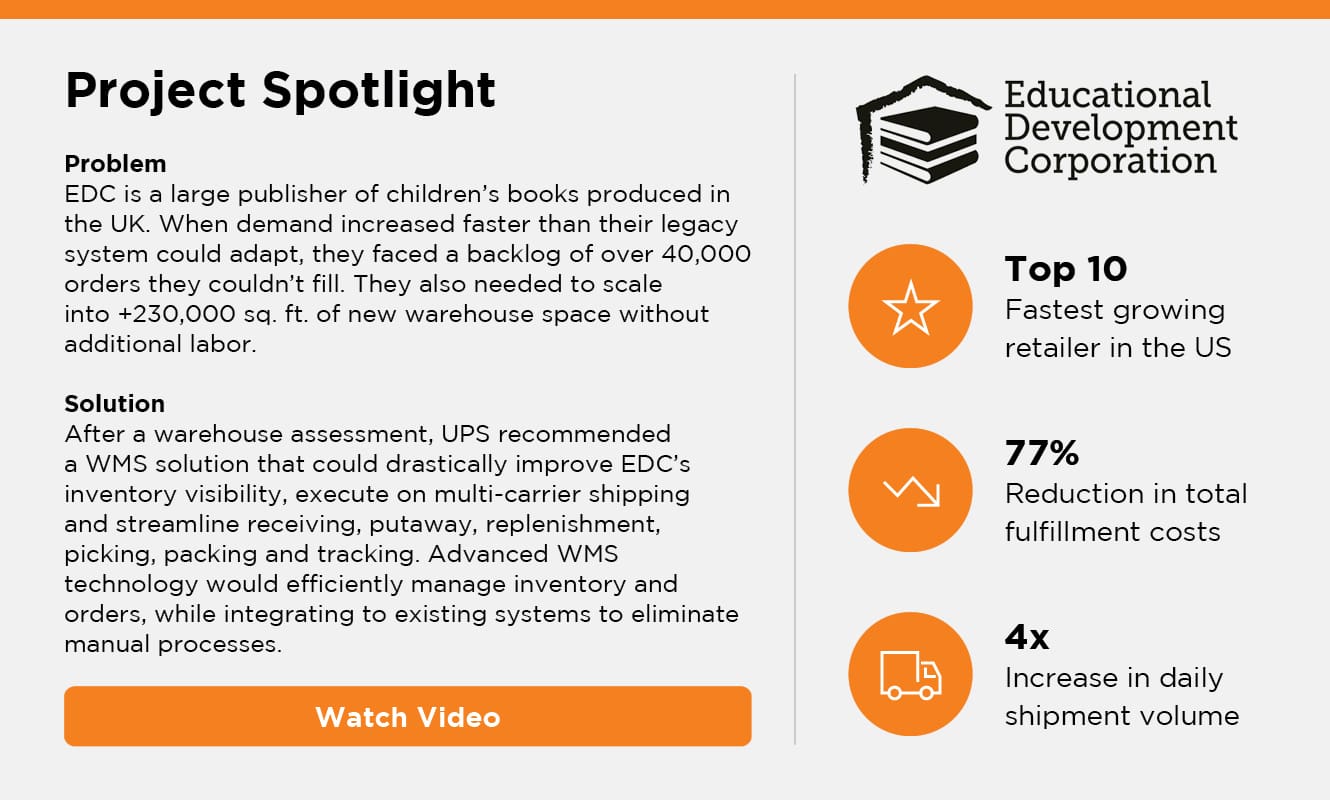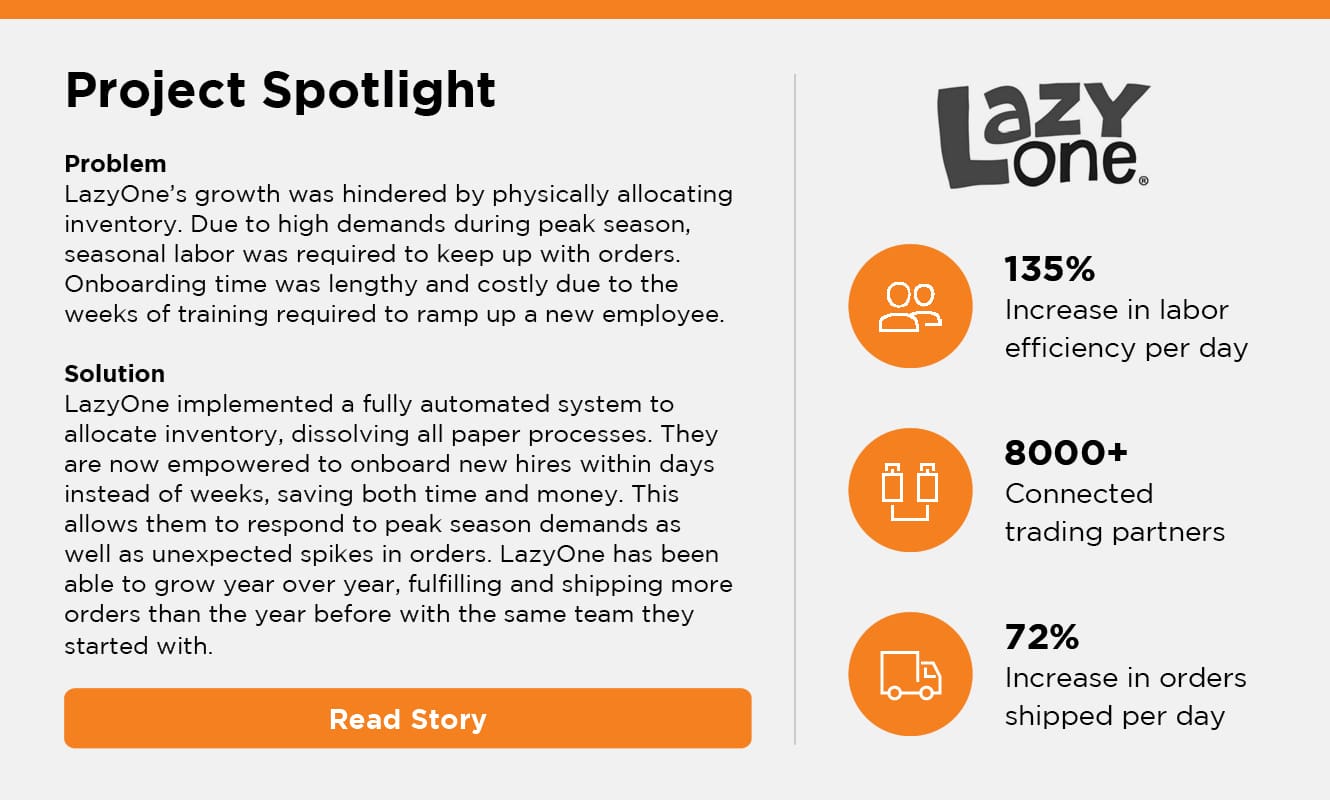Knowing the best practices for warehouse management has never mattered more.
Chaotic fluctuations in supply and demand, continued labor challenges, and last-mile fulfillment congestion have forced many operational ‘blind spots’ on warehouses not initially set up for ‘boundaryless’ commerce. As order volumes grow, companies are realizing the accelerating impact that manual processes, stale or siloed data, human error, and poor visibility into staff performance can all have on growth:
- 67% of companies said that being out of stock after an order is placed, or simply overselling, is the top inventory mistakes that lead to lost customers
- 69% of customers are much less likely to shop with a business in the future if a purchase is not delivered within 2 days of the date promised
- Human error is the #1 root cause of fulfillment issues for 62% of companies
- Labor makes up the majority of the total cost of warehouse fulfillment (not including shipping)—order picking alone accounts for about 50% of a warehouse’s labor costs
These trends have many companies searching for warehouse management best practices that can better grow their business.
Today we’ll share the 7 techniques and investments in a warehouse management system that can do more, and do it faster, better, and smarter.
Effective warehouse management is a top tech priority
Modernizing the warehouse for modern fulfillment is the smartest growth investment a company can make right now. It’s a top tech priority; but for many, the path to managing warehouses effectively is blurry:
Zebra’s global Warehousing Vision Study of tech plans to modernize warehouses from 2019 to 2024 found that 77% of companies agree that augmenting workers with tech is the best way to introduce automation in the warehouse.
Yet, only 35% of companies clearly understand where to start. Today let’s bring that journey into sharp focus for your business:
- Why are modern warehouse management systems a top priority right now?
- What does modern warehouse fulfillment look like?
- Who gets there and how?
- What warehouse management strategies and tools can illuminate your growth path?
New insights prove, It’s Grow Time™
The tipping point for spreadsheets
When online consumer spending hit $791 billion in 2020, a 32.4% YOY jump, massive uncertainty triggered an interesting shake-up. Some warehouse managers responded to higher order volumes by increasing budgets and headcount.
Others saw this as an opportunity to trade in their spreadsheets and paper-based warehouse processes for advanced warehouse management software that empowers associates to take fulfillment speed, accuracy, throughput, and customer satisfaction to the next level.
Myth: only top-tier warehouses win
Some interesting data came out that debunks the myth: ‘only top-tier warehouses can do fulfillment right’ and grow:
While Amazon’s 10-year streak of positive YOY sales growth continued in 2020, the once “untouchable” fulfillment engine lost market share among the Top 1000 retailers in that same year.
509 companies in the Top 1000 grew their online sales by over 25% in 2020. Proof that even businesses with much smaller budgets can win.
Fact: modern warehousing methods win
It’s not about company size
It’s about your proximity to the customer. The experience and the perception customers get every time they interact with your company. This is about taking manual tasks off your associates’ hands and empowering them with timely customer insights to reduce costs, increase labor efficiency, and improve decision-making on the continuum to profitability at scale.
It’s about increasing results, not headcount
The highest operating cost in a warehouse is labor, which G2 says accounts for 50-70% of the warehousing budget. Eliminating manual or paper-based tasks fuels growth by dramatically increasing the number of orders your company can accept and fulfill, in a shorter amount of time, without increasing staff.
Purpose-built WMS systems bring a huge competitive edge, too. They help you quantify, track, allocate, promise, and manage inventory correctly. You can earn more, reduce errors and fulfillment costs, increase throughput, and extend your labor investments.
7 factors that fuel growth right away
Warehouse management systems accelerate your growth by removing costly blind spots in 7 key areas. Fixing these blind spots will open up immediate profitability:
- Enterprise Visibility – Do I know how much inventory I have? Is it accurate?
- Inventory Management and Tracking – Do I know where my inventory is located?
- Real-Time Allocation – Do I know if my inventory has been allocated to an order?
- Labor Costs – How do I manage warehouse staff performance?
- Backorders – How do I eliminate backorders?
- Peak Demand – How do I handle seasonal spikes?
- Online Inventory – How do I show available-to-promise inventory on my website accurately?
Let’s look at each of these—why they are vital to growth, along with some warehouse management strategies you can use right now to improve:
#1: Do I know how much inventory I have? Is it accurate?
Why this matters
Some things don’t scale. As order volumes grow, so does the impact of improperly representing inventory on hand. This leads to backorders and overselling, higher costs, and frustration among your operations team. Increasing orders mean more mistakes, slower fulfillment times, and no time to uncover opportunities to trim costs—such as rate shopping for shipping cost optimization.
How to improve enterprise visibility
Trade in tribal knowledge for a single source of truth that can keep pace with modern commerce. Warehouse management systems automate time-consuming, error-prone processes while delivering enterprise-grade visibility, flexibility, and real-time data generation.
These systems create fluid processes for your team and a fully traceable, unified view of all warehouse operations. Save tons of valuable time and costs when you have one solution that can seamlessly handle all of these things in one spot, in the cloud:
- Inbound/outbound tracking
- Streamlined waving, picking, packing, putaway, and returns
- Advanced cartonization services
- Printing B2B retail-compliant labels
- Multimodal shipping management
- Centralized inventory knowledge across all warehouse activity
According to IndustryWeek, organizations implementing a best practices warehouse management system report 4% higher perfect-order performance on average than those without these systems.
In addition, companies have seen a 150% increase in fulfillment efficiency; +99.95% accuracy; and fulfillment time within 24 hours on average with a WMS.
#2: Do I know where my inventory is located?
Why this matters
How much time do your warehouse managing associates spend searching for inventory that’s in the wrong place? Or simply not there? What do manual inventory processes cost your business?
G2 shared that order picking alone accounts for 50% of a warehouse’s labor costs. In addition, human error from manual processes is the #1 root cause of inventory fulfillment issues for 62% of respondents. These problems create more backorders, overselling, sub-optimal or poorly timed replenishments, higher on-hand inventory and labor costs, and broken customer promises.
Improve warehouse inventory management and tracking
Employ an automated cycle count program that constantly audits your inventory for accuracy. Effective warehouse inventory management systems direct replenishments to confirm that inventory movement is handled appropriately.
This dramatically improves productivity, while keeping everyone on the same page about what’s in stock, what’s needed, and how to proactively plan as order volumes rise.
#3: Do I know if my inventory has been allocated to an order?
Why this matters
Without the proper representation of available-to-sell quantities, your warehouse can’t correctly prioritize, process, or ship orders. It’s a best guess as to whether an item will be back-ordered before being released to the warehouse for fulfillment. There’s no way to communicate back-orders or fulfillment delays to your customers in a timely fashion. They get mad, and you either lose the sale or compromise margins to make it happen.
How to automate inventory allocation
Intelligent warehouse management systems use flexible rules to incorporate allocation into all customer orders needing to be fulfilled, including how to allocate, when to allocate, and in what priority. Warehouse management best practices and rules consider inventory allocation in real time when determining what’s available to sell. Some tools offer extensive order waving and batching capabilities that can automatically allocate inventory to customer orders. They can even consider order types and profiles.
This is especially useful with multiple sales channels that and detailed inventory allocation rules. Teams can easily prioritize what gets allocated to which types of customer orders. Look for WMS tools that dictate not just what inventory is allocated but where to allocate it based on sales channels and factors that influence profitability — such as fulfillment speed and operational costs.
#4: How do I manage warehouse staff performance?
Why this matters
Warehouse worker salaries have increased 38% in the last 5 years. So YEAH… Employee performance matters!
As your business grows, replacing blind, paper-based methods with a digital process to evaluate warehouse staff performance will improve critical KPIs. According to G2, 89% of organizations already use modernized Warehouse Management Systems functionality for labor planning and management.
How to reduce warehouse labor costs
Make your labor investments count. Put a system in place that can track and record all user activities that matter to your business. The WMS should be able to feed this data into real-time reports and dashboards, so managers can easily track performance across the organization in many ways — and deploy those resources optimally to reduce warehouse labor costs.
#5: How do I eliminate backorders?
Why this matters
Don’t sell what you don’t have. That’s the fastest way to lose customers you’ve had for a long time.
Beyond the trust factor, other items in the same order could be in stock, but the back-order causes you to lose the sale altogether. Or, the order may get split and shipped at different times, further inflating your cost.
According to Multichannel Merchant, ecommerce backorders can cost $15-$20 each, eroding profits.
How to eliminate backorders
A simple, pre-built warehouse management integration is a best practice that significantly reduces backorders and overselling by connecting inventory data closer to the sale. These WMS software integrations ensure that accurate inventory is in the system at all times by publishing real-time Available-to Sell data to sales channels.
Shopify is one example. Without customization, you can integrate Shopify directly with your WMS solution. So that when inventory adjustments are made, information gets communicated back to sales channels on the fly.
#6: How do I handle seasonal spikes?
Why this matters
Ecommerce is a game of seconds, especially as supply chain disruptions continue to threaten product availability. Salesforce expects logistics complications alone to result in $163 billion of added costs compared to peak season 2020. That means continued out-of-stocks and disruptions.
While there’s not much you can do to control industry-wide supply issues, the best practice is to get your warehouse management team organizationally primed for optimal execution all year long.
How to manage peak and seasonal demand
Explore solutions that enable your teams to process orders faster. Using advanced technology with system directives, validation, and warehouse processes, many warehouse management systems support system-directed put-away, user-directed put-away, and stock replenishments for different types of inventory based on volume or popularity.
Simple adjustments can shave seconds, minutes, or even hours off your processing times. Even in smaller warehouses, those seconds create significant annual cost savings while improving daily throughput, sales, market share, and profitability.
#7: How do I show Available-to-Promise inventory on my website?
Why this matters
‘Because competitors do it.’
True. But more compellingly, it’s because that’s what today’s consumers expect. This becomes even more important if you plan to expand your warehouse space, add locations, or introduce new sales channels such as Direct-to-Consumer (DTC) order fulfillment.
Omnichannel shoppers have a 30% higher lifetime value than those who shop using only one channel. 51% of firms use at least 8 selling channels. The more you scale, the more selling channels you’ll need to add. The more selling channels, the more logins/platforms accessing your website, leading to more data silos and a greater urgency for an instant, accurate representation of inventory online.
How to show accurate inventory online
If your online inventories are always off, it’s time to apply some science. Best-in-breed warehouse management systems like Deposco offer WMS Software Integrations that automatically sync Available-to-Promise (ATP) inventory calculations to all sales channels. These integrations calculate ATP numbers as:
On Hand Inventory
– Allocated Inventory
– Unavailable Inventory (on hold/damaged/not pickable)
________________________________________________
Available to Promise
Streamlining your warehouse management best practices right now to allow real-time inventory tracking, labor management, and data access in one system will cut a clearer path for growth later.
Turn the lights on
Ready to confidently understand where your inventory is, how your associates are performing, make promises you can keep, and save time and capital along the way? Need someone to turn the spotlight on your modern warehouse?



